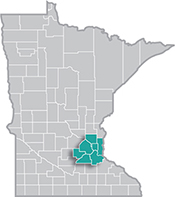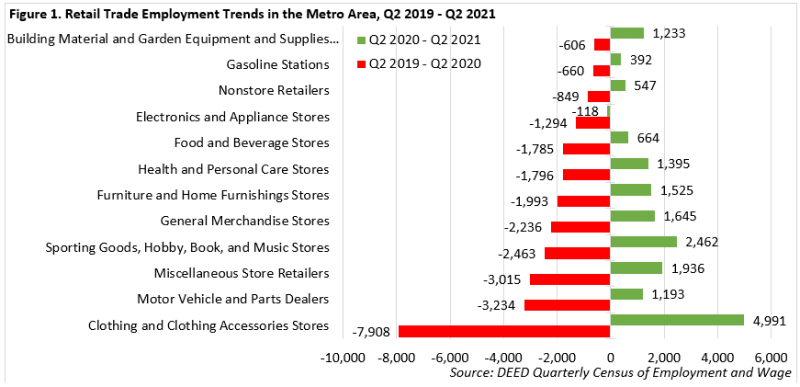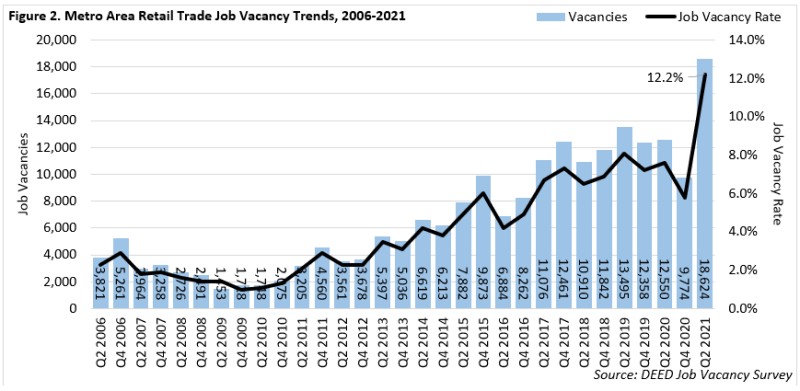 The Minneapolis-St. Paul metropolitan area is a national leader in finance, advanced manufacturing, agriculture and retailing.
The Minneapolis-St. Paul metropolitan area is a national leader in finance, advanced manufacturing, agriculture and retailing.
Medical devices, electronics and processed foods are strong suits recognized globally.
Want the freshest data delivered by email? Subscribe to our regional newsletters.
12/6/2021 9:00:00 AM
Tim O'Neill
The holiday season is upon us, and what better way to celebrate than to analyze trends in Retail Trade? Whether it's topping off the car at the gas station, shopping for gifts at department stores or specialty shops, getting groceries or wine and beer, or just getting flowers to decorate, most of us rely on Retail Trade services during the holidays – and throughout the rest of the year.
And the importance of Retail Trade is reflected in the numbers. According to DEED's Quarterly Census of Employment and Wages (QCEW) program, Retail Trade is the Metro Area's third largest-employing industry sector falling only behind Health Care & Social Assistance and Manufacturing. As of the second quarter of 2021, the region had nearly 8,600 Retail Trade establishments supplying over 154,000 jobs. As such, nearly one-in-ten Metro Area jobs are Retail Trade jobs (Table 1).
Zooming in, about 40% of Retail Trade employment is within General Merchandise Stores and Food and Beverage Stores, with each of these subsectors accounting for over 30,000 jobs. Other large employing retail subsectors in the region include Motor Vehicle and Parts Dealers, Building Material and Garden Equipment and Supplies Dealers, Health and Personal Care Stores, and Clothing and Clothing Accessories Stores.
Overall, the Metro Area accounts for approximately 55% of Minnesota's total Retail Trade employment, making it slightly less concentrated in the region than in other parts of the state. The Metro Area does, however, have high concentrations of the state's total employment in Clothing & Clothing Accessories Stores, Furniture & Home Furnishings Stores, Electronics & Appliance Stores, and Health & Personal Care Stores.
Average wages in Retail Trade are typically lower than wages in other industry sectors. The average annual industry wage for Retail Trade in the Metro Area, $37,908, was about half the average annual wage across all industries in the region, $71,552. Average annual wages in Retail Trade are higher in Nonstore Retailers ($73,216) and Motor Vehicle & Parts Dealers ($68,120) and lower in Sporting Goods, Hobby, Book, & Music Stores ($25,532), Clothing & Clothing Accessories Stores ($26,052), Gasoline Stations ($27,196), and Food & Beverage Stores ($27,300).
| Industry | Number of Firms | Number of Jobs | Share of Statewide Employment | Avg. Annual Wage |
|---|---|---|---|---|
| Total, All Industries | 90,576 | 1,677,205 | 60.4% | $71,552 |
| Retail Trade | 8,574 | 154,168 | 54.7% | $37,908 |
| General Merchandise Stores | 464 | 31,379 | 55.4% | $29,796 |
| Food and Beverage Stores | 1,131 | 30,130 | 54.8% | $27,300 |
| Motor Vehicle and Parts Dealers | 786 | 16,992 | 49.8% | $68,120 |
| Building Material and Garden Equipment and Supplies Dealers | 451 | 15,529 | 52.8% | $36,036 |
| Health and Personal Care Stores | 1,013 | 10,826 | 65.1% | $45,448 |
| Clothing and Clothing Accessories Stores | 1,088 | 10,559 | 70.7% | $26,052 |
| Gasoline Stations | 759 | 8,422 | 32.8% | $27,196 |
| Miscellaneous Store Retailers | 1,080 | 7,430 | 59.2% | $32,032 |
| Sporting Goods, Hobby, Book, and Music Stores | 481 | 6,792 | 62.1% | $25,532 |
| Nonstore Retailers | 568 | 6,645 | 55.5% | $73,216 |
| Furniture and Home Furnishings Stores | 424 | 5,481 | 69.0% | $49,036 |
| Electronics and Appliance Stores | 329 | 3,979 | 65.8% | $52,624 |
| Source: DEED Quarterly Census of Employment and Wages (QCEW) | ||||
The COVID-19 recession significantly affected Retail Trade employment in the Metro Area. Between the second quarters of 2019 and 2020, the industry lost 27,841 jobs (-17.0%). Employment losses were most significant in Clothing & Clothing Accessories Stores, Motor Vehicle & Parts Dealers, and Miscellaneous Store Retailers (Figure 1). Over the past year, however, Retail Trade employment has started to recover. Between the second quarters of 2020 and 2021, the industry gained 17,867 jobs (+13.1%). Growth during this time was led by Clothing & Clothing Accessories Stores; Sporting Goods, Hobby, Book, & Music Stores; Miscellaneous Store Retailers; and General Merchandise Stores.

As the Retail Trade industry continues its recovery from the COVID-19 recession, the demand for workers has spiked to new records. According to DEED's Job Vacancy Survey (JVS), Metro Area Retail Trade employers reported over 18,600 job vacancies during the second quarter of 2021. This is up nearly 6,100 vacancies, or 48.4%, from one year previous. The job vacancy rate, which is the percent of job vacancies relative to all filled jobs, has also climbed to record highs for Retail Trade. The 12.2% job vacancy rate during the second quarter of 2021 essentially reveals there are about 12 open positions for every 100 filled jobs in the industry.
Specific sales occupations with the most vacancies reported in the Metro Area include Retail Salespersons, First-Line Supervisors of Retail Sales Workers, Cashiers, Counter & Rental Clerks, and Sales Representatives.

Contact Tim O'Neill, Labor Market Analyst.